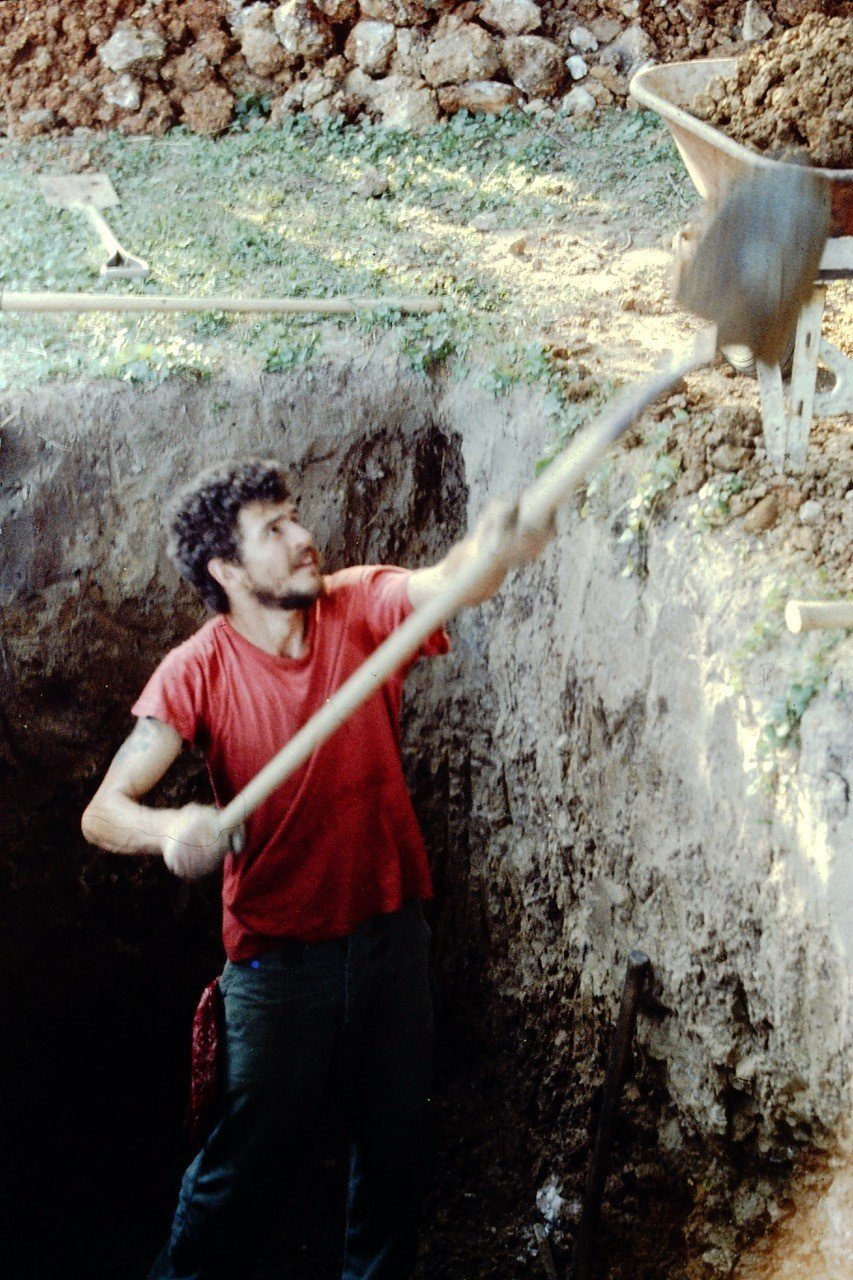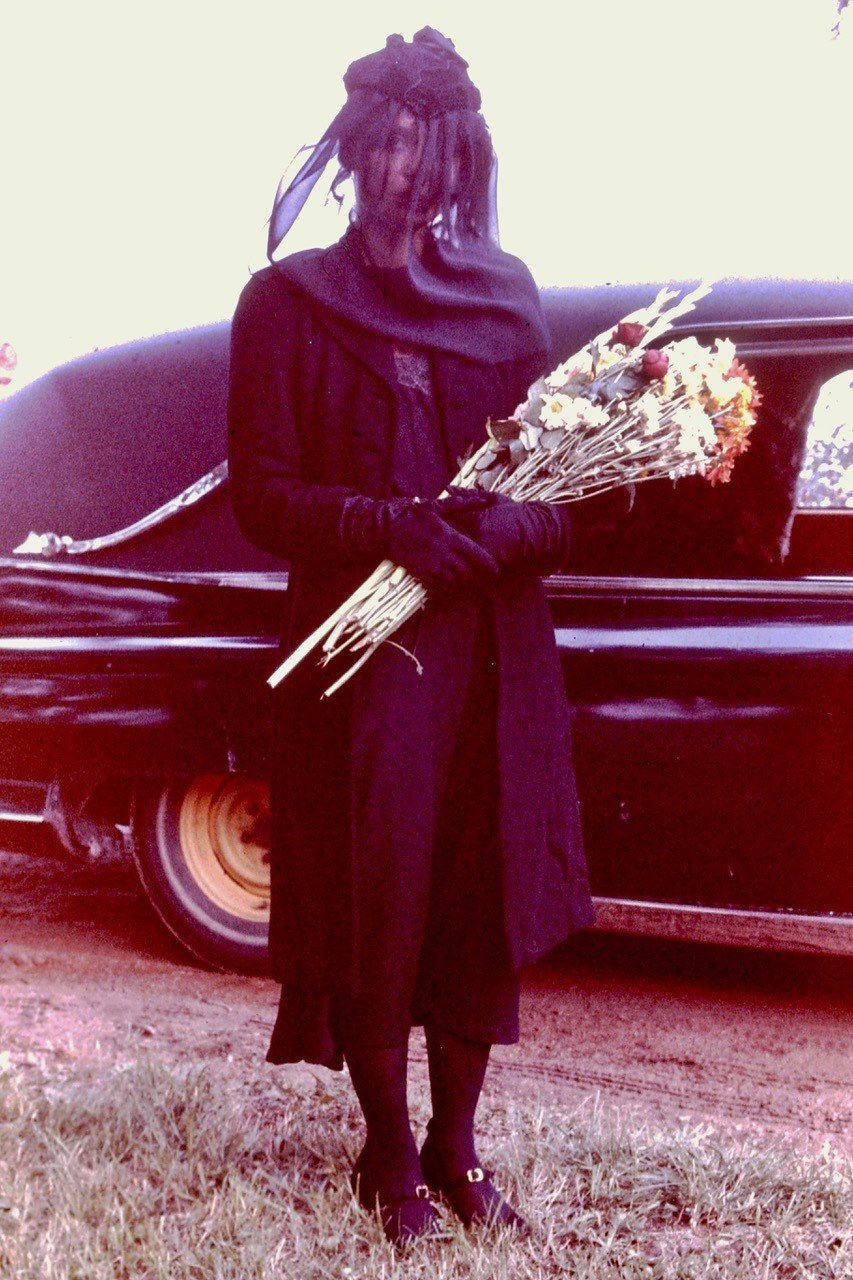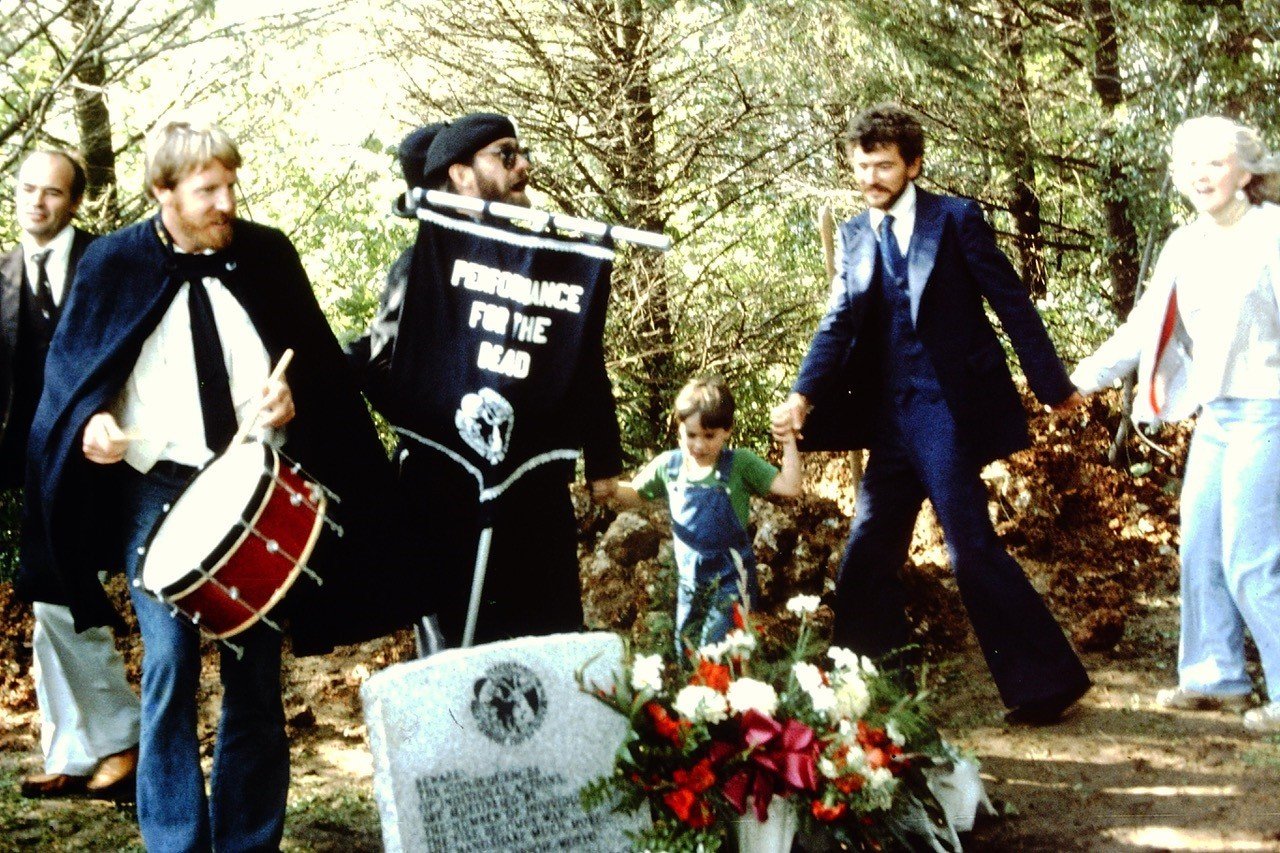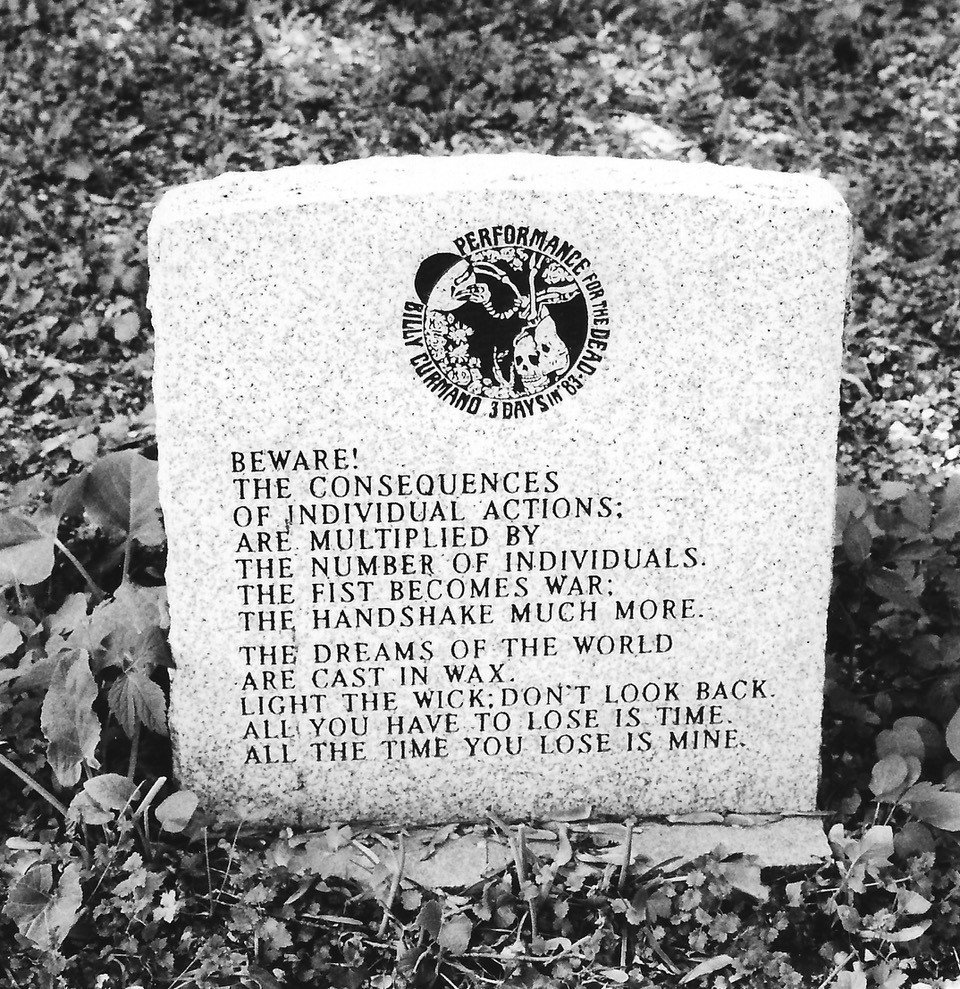Billy X Curmano
Full Moon Exhumed Zoom: Billy X Curmano – 40th Anniversary of “Performance for the Dead” was presented on September 29, 2003 with Franklin Furnace's LOFT, and a video of this event can be accessed by clicking HERE
Nicolás Dumit Estévez Raful Espejo Ovalles Morel: Billy, we connected today over the telephone about some of the elements of your upcoming celebration with Franklin Furnace’s Loft. Is there anything that you would like to say regarding this historic gathering? After all it has been 40 years since your Performance for the Dead took place.
Billy X. Curmano: When I look back, emotions well up. There always seems to be saber rattling and talks of war. Back then, nuclear war was on the table. I remember a high-ranking US official – really just another talking head on TV – saying all you need are shovels and some dirt to protect yourself from nuclear fallout.
“Climate… War…slow down. Maybe we’re better off underground”
We haven’t learned much. Wars are going on around the globe. Russia threatens nuclear war once more. Greed has guided special interests to ignore the dangers of climate change. I have always wondered how great societies and cultures failed. Now, I realize – as smart as we think we are – we may well be heading that same way. I sometimes think of Otis Redding’s lyrics, “It’s been too hard living, but I’m afraid to die. I don’t know what’s up there, beyond the sky.” I guess that’s what makes death exciting – Maybe it’s an adventure. No one knows for sure.
NDEREOM: One of my biggest fears, and that of many, has been to be buried alive. There is for example the safety coffin that was developed in the 18th and 19th centuries to make sure that this would not happen. Were there any fears for you during the performance and how did you work with them?
BXC: There were definitely fears. I was probably fascinated by reading Edgar Alan Poe’s Premature Burial as a child. I love to read, so I usually do a great deal of research on projects. I wanted to be buried alive, but I also wanted to be exhumed alive. Of course, I had never been buried, so I wasn’t sure what mishaps could occur. I built some safety devices into the project. The burial vault had about 3’ x 3 1/2’ x 6 ‘of useable area. Once buried, I could come out of the coffin, break it down and perform for the dead in that very tight space. Like a darkroom, it was absolutely free of light. I had a sketch book and did some drawings in the darkness. I thought they would somehow be guided from the spirit world, but alas they appear to be mainly just scribbles. I have never shown them.
September in MN can get cold especially underground. The floor, walls and ceiling of the vault were insulated to protect me from hypothermia. It was especially important because I was fasting. By the time I was exhumed, I had been fasting for seven days and would have been very susceptible to the cold. Rain was always a threat, so a deeper hole was dug below the burial vault to drain water away. A small trap door was cut in the vault ceiling. It was hinged to open inwardly. If things went bad, I could unlock it. Theoretically, the weight of the earth would push it open and fall into the crypt. I had an entrenching tool to hopefully dig my way out. Volunteers that worked on the project feared for my safety as well. One architect wanted a fan in the air exchange system. I did not want that. The 60-cycle hum of a fan would have been constant and distracting. It was also suggested I be wired in some way to monitor life signs. I wanted to remove myself from worldly things. I wanted to limit distractions so I could commune more fully with the spirit world. I vetoed those ideas. Several volunteers quit the project when our ideas for my safety were at odds.
NDEREOM: The conversation on death is changing so much and so rapidly. Like with other systems that are getting dismantled, the conversation on impermanence is not the taboo that it was 10 or 20 years ago. How did people around you respond about your idea to stage your own funeral while alive?
BXC: Responses were varied. There were many volunteers and supporters that actually made the project possible. Yet, there were those outside the circle that seemed threatened. A hastily scribbled piece of hate mail arrived at my studio. We hung that in the Postal Exhibition, but it gave me pause. I took it seriously enough to add “security teams” at the gravesite for the entire interment.
The director of the Winona Art Center suggested the former church as an ideal site for the visitation. His assistant agreed. The offer was withdrawn after an impassioned speech from a board member insisted it would ruin the center’s reputation. In another instance, we applied for regional arts funding. It seemed the burial itself – kind of the main “act” – flew over at least one panelist’s head. I still remember her words, “I love the idea of a jazz funeral, the Wake and International Postal Exhibition, but why does he have to be buried? Couldn’t they just bury a doll?”
That rejection crushed me. The project was complex with a lot of costs. I felt dejected as I mulled over the consequences at a nightspot. An acquaintance I barely knew asked what’s the problem? I told him the burial grant was rejected. He asked, “What do you need?” I replied funding. He repeated, “What do you need?” I realized he was a doer not a money man. I ran down the list. When I got to burial vault, he asked for dimensions. He promised to build it. A few weeks later a flatbed truck with a hand built, solid oak burial vault arrived on site. The local monument company donated the Mount Airy Granite tombstone along with its inscription. The coffin, banners, armbands, antennae flags, hearse, etc. were all donated. The grave was dug through a series of grave digging parties. The visitation was moved to a Victorian mansion that had been a bishop’s residence. The Italian Wake was staged in a modest apartment. A jazz historian offered to pay for the band. He worked with the musicians to assure authenticity to the New Orleans tradition. Jazz funerals evolved from the lowest classes of laborers: the Africans, Italians and Irish. Their lives were very hard. So much so, it seemed almost better to mourn the birth and celebrate the passage. The soul traveled on to a final reward. Joe Hill’s song The Preacher and the Slave referred to it as “Pie In the Sky when you Die”.
Competitive burial societies were created with bands, banners and grand marshals. The members paid dues that were used for their end of life celebrations. The funerals were lively and upbeat until the corpse was interred. Then, it turned somber. It didn’t really have to be rehearsed. The attendees came from near and far and were taken up by the excitement. I was already buried and unaware of this at the time, but it is evident in the video. A seriousness fell over the group – perhaps when they realized they had actually buried someone alive.
NDEREOM: I am not getting into the questions that most people will likely ask during the 40th anniversary of your Performance for the Dead at Franklin Furnace. I will leave those questions for that night. In the meantime, I would like to ask about your preparation for the performance. Can you talk about the practices that you undertook to enter the space of death and were they of help?
BXC: I have always thought of my body as an instrument. I use meditation, yoga and physical exercise to keep it tuned. I trained more intensely in preparation for the burial. I studied and added self-hypnosis as another tool. I read and sometimes re-read sacred texts. I had never actually read the Bible cover to cover, so I did that. I went on to the Gita and Koran, Zen parables, Tibetan and Egyptian Books of the Dead. I followed up with more recent writings like Kübler-Ross On Death and Dying. I followed her suggestion to attend the funerals of strangers. It enables you to sense a great loss without the added psychological trauma experienced when a loved one dies. I hoped my burial might even be cathartic for those in attendance.
I think this practice readied me. I began to see Death’s Door as simply another of the doors of perception. I invited those on the other side to come through. I had some visions and even saw a white light. I felt if I went into the light I could pass through, but could I come back? Or was the light just residue from reading about death? I doubt I will ever know for sure – at least in this life.
NDEREOM: I am of the opinion that the veil dividing my dead ones from the living is thin and I tend to have conversations with those who have departed. I usually ask for their protection and seek to honor their memory. Was there any dead person in the circle of presences who guided you or that you thought about during your performance?
BXC: I have communicated with loved ones that have passed. Spirits sometimes enter my dreams, but they are not always benign. Perhaps that’s how dreams become nightmares. I sometimes rely on spirits to guide me. I am careful because I believe some spirits are tricksters that have fun at my expense. I struggled with one recurring spirit for several years. This spirit somehow manipulated me. Somehow it sent me into a deep woods on a full moon night. I felt a cold darkness and thought I may be in danger. An opossum and a night hawk joined me and at that moment I realized everything was alright. My perceived struggle with this spirit guide resolved itself that night.
During the burial, fasting, isolation and absolute darkness made me unsure of reality. There was a point where I touched my eyes to determine whether they were opened or closed. I had visions in the darkness. I wondered if the figures I saw were spirits or if I was hallucinating. I saw a horrifying figure whose face melted before my eyes. Was it a demon from my past? Was it a casualty? Was it conjured up from horror movies? I remembered some violent deaths. Jay, a high school best friend killed in Vietnam and Gary another young man lost in that war. I was most comforted when my father, who was already dead, came to me. Even when he was unsure of my projects, he was always willing to help. He seemed well pleased with this one.
NDEREOM: What is the role of community/communities in your performance(s)? Where I come from, a dead body is not meant to be left alone. There are supposed to be people with the body at all time during the funeral. This has changed with the advent of the funeral industry. So, my question is about kinship at the final hour. How did you involve community/communities in preparation for your performance, and how did you experience it/them as the performance unfolded?
BXC: It seemed the concept itself captured the community. They were very supportive and involved. There were meetings and discussions on how to move forward. As the corpus, I had very little control. I plotted and planned, but in the end the community took control. Things developed organically.
During the Wake, people lifted me from the chair and danced with me. Some kissed and touched me as I remained lifeless. I wore dark glasses to conceal my eyes and kept my face motionless. At times, it was hard to keep from smiling. During the Jazz Funeral, I lost more control. I overheard the hearse operator and pall bearer talk about stopping at a bar I sometimes frequented. I couldn’t offer any opinion. They just suddenly did a U-turn. The whole funeral procession U-turned and followed. They carried the coffin inside, opened it and stood it upright on a table. The bar filled with mourners and they toasted the corpse one last time. Or maybe it was a little more than one – I forget.
The rains did come. The support team had to dig a trench around the grave to move the pooling waters away. The rain was flowing rapidly into the burial vault, but I was able to deflect it into one of the drainage holes. The performance had gained a certain amount of notoriety as articles were carried by the Associated Press and other national/international sources. A news crew came in by helicopter from the Twin Cities and tried to convince or intimidate the support team to dig me up early – so they could make the six o’clock news deadline. The support team stayed strong and exhumed the corpse at the prescribed time. The reporters always seemed disappointed when I insisted I was exhumed rather than “risen”.
NDEREOM: In the past, I have studied about death and dying with the Living/Dying Project, where I continue to learn with Dale Borglum. I also co-host a death and dying circle with Healing Circles Global. I am currently studying with Jerrigrace Lyons at Final Passages to become as a Death Doula, which was probably not a common training that people undertook when your performance happened 40 years ago. Similarly, Linda Mary Montano has been an amazing teacher on the subject. Who were those who helped you walk to the other side and which were their roles?
BXC: The preparations to be buried alive were complex. As the corpse, my role was limited. The grave had to be dug (there were grave digging parties for that), a burial vault and coffin were constructed, there were banners and costumes. My intimate friends helped me prepare.
We included credits and the roles of participants with the In Sympathy Postal Art exhibition catalog. The overall project director was Phyl Lauer. Dr. David Christenson, MD served as a medical advisor. I was worried that the authorities may try to stop the burial, so attorney Stephen Delano became a legal advisor. Two architects, Scott Halweg and James Malonophy, aided in the burial vault design. Scot was also the grand marshal leading the Jazz Funeral procession. His sash was created by Jewel. Two art historians, Dr. Wallace Nils Johnson and Deborah Leuchovius, provided research. The custom-tailored pine coffin was created by Buddy Baker and assisted by Laura Baker and Idella Burmester. The solid oak burial vault was constructed by Bill Roth with the assistance of Boo, Steve-E. Petras, and Jake-A-Mado. The Mount Airy Granite tombstone with inscription was donated by the Winona Monument Company. The large Performance for the Dead banner was created by Rita Keller with smaller banners, armbands and auto pendants done by Laura Hall. Video services were provided by Paul Woodworth of VideoDocument. Still photographers included Steve Firkins, Kimberly Haedtke and Teri Halweg. Patsy Tully recorded the self-guided farmhouse studio tour.
Besides my own efforts in grave digging and general groundwork these volunteers dug in: Carl Lacher, Paul W. Schollmeier, Tony Greensward, Steve Firkins, Clyde Stutesman, Scott Halweg, Huckleberry Gabe, Teri-Halweg Gabe, Vernon Robert Wobschell, Lesley Charlton, Alima, Kimberly Haedtke, Kathleen, Adam, Suzanne and Michael Paul, Carol De Lorenzo and Mitchel Rice. The Wake Hostess and principle researcher was Evelyn Roehl. The Jazz Funeral was hosted by Kathy Christenson and Connie Forest. Jack Lucas served as Jazz Historian with the Gate City Ragtime, Dixieland, Jass and Philharmonic Society: Gary McDowell, Norm Baron, Morrie Schuh, Chuck Bentley, Dr. Dan Barr, Duane Peterson and Jim Murray.
Milo Billman provided comfort and words as a community minister. Keith Tungesvik was the 1961 Cadillac Hearse owner and operator. Mischa Bulger coordinated food and drink.
Kevin Pomeroy, Bill Crozier, Steve Firkins and D.L. Hunt were pall bearers. Carol DeLorenzo coordinated the two-person graveside vigil – day and night for all three days. Of course, the In Sympathy postal artists were supportive. They are listed in the catalog.
NDEREOM: Tell me about the Buried Alive Performance kits that you are generating. I know that Franklin Furnace, and The Interior Beauty Salon, among others, have already ordered a kit for their archives.
BXC: I was in the archives to collect material for the commemoration and realized this should be shared. The kit comes in a signed and numbered black corrugated box with the Performance for the Dead logo. It contains suggestions for your party along with an actual burial stone from the original 1983 Minnesota Gravesite along with its certificate of authenticity. at the time of the performance, I collected a small crate of burial stones. I have carried them with me for 40-years. It’s time to send – at least some – of them off. There is a copy of the unsolicited County Medical Examiner’s Death Certificate. Two of the original postcards and a funerary memory card. The Household Word Project which “May be a cheap trick now, but it’ll be art when I’m dead”. The Meet Your Maker Fashion and Etiquette Guide has suggestions of what to wear and how to act in those final moments. The Search (For the Spiritual in Art) DVD with 3 major works including the burial and lastly the 1983 In Sympathy Postal Art Catalog with lots of credits rounds out the package. It’s a steal at $29.95 plus tax and shipping.
NDEREOM: It is a steal! Billy, a HUGE thank you for talking with me. I will see you soon, virtually, and hopefully in person as well. I thank Harley Spiller for introducing us more than a decade ago.
BXC: I am very delighted to be in your orbit and thankful that our friend Harley made it so. I look forward to seeing you soon and hope it can be physical as well as virtual.
All photos: Courtesy of Billy X. Curmano
Billy X. Curmano / links : Website / AIOP / Facebook / Spotify
Billy X. Curmano is known for extended performances like a 3-day live burial, 2,367.4-mile Mississippi swim, and 40-day desert fast all with serious environmental and social justice underpinnings tempered by irony and satire. An amused Journalist dubbed him, “The Court Jester of Southeastern Minnesota.”




